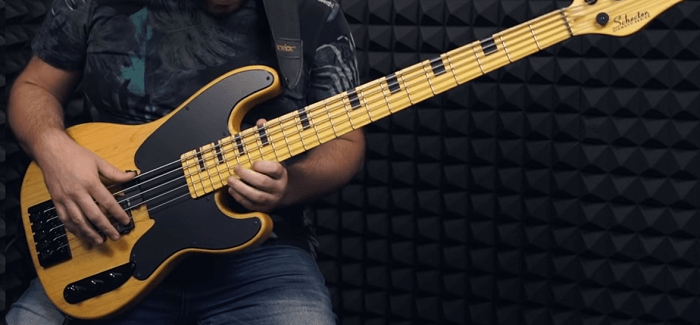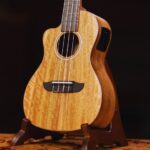Are you thinking about whether to purchase a 4-string or 5-string bass guitar? Knowing the difference between these two types of bass guitars will help you decide which one is best for you. What are the differences between four and five-string bass guitars?
Aside from the number of strings, the 4-string bass has a thinner neck, so it is easier to play, especially for beginners. The 5-string bass has more notes as there is an extra string, but it has a thicker neck and is generally bulkier and heavier.
Read on to learn more about the differences between a 4-string and 5-string bass guitar.
Also, for an excellent 4-string bass guitar, take a look at our top pick, the Yamaha TRBX Series Bass Guitar:
Click here to see it on Amazon.
Differences Between Four and Five String Bass Guitars
| 4-String Bass Guitar | 5-String Bass Guitar | |
| No. of Strings: | 4 | 5 |
| Weight: | Lighter | Heavier |
| Size of Neck/Body: | Smaller | Larger, wider in girth |
| Notes in Standard Tuning: | E, A, D, G | B, E, A, D, G |
| Variety of Notes Played; Versatility: | Fewer notes, scales, arpeggios, and note expansion; less versatile | Allows more notes, scales, arpeggios, and note expansion; more versatile |
| Enhancement of Music Due to Extra Octave: | Cannot play tones from a lower string | Can enrich tones due to two additional string |
| Mobility and Ease of Use: | Offers more mobility due to ease of use for beginners | Less mobility and ease of use for beginners. |
| Cost: | Usually less expensive | Usually more expensive |
These are the major differences between a 4-string and a 5-string bass guitar. Nevertheless, some of the differences wouldn’t matter to a professional bass player, as they could play expertly whatever type of bass guitar they hold in their hand.
This would also depend on your playing preferences. You can fulfill the role of a bass guitar player in your gigs using the 5-string, but if you’re a newbie player, the 4-string bass is recommended for you.
The 4-String Bass Guitar and Its Features

In the 1930s, American musician-inventor, Paul Tutmarc, began developing stringed instruments. He built one of the earliest electric bass guitars. In the 1950s, Leo Fender, an enterprising businessman in the US, designed musical instruments that are still widely used up to this time, such as the Fender Precision Bass, among many others.
The first bass created was the 4-string bass, and musicians found no problems playing with it. However, from then on, inventors tried to enhance the features of the bass guitar to provide clearer and better sounds. Later in the 1960s and onwards, the 5-string and 6-string bass were introduced by Fender, followed by other musical instrument inventors.
Body
The body of the bass guitar is generally made of wood, such as mahogany, ash, or alder. The body may house the bridge and the nut of the guitar. It features preamps and control keys, where you can control the volume and quality of the sound.
Neck
The bass guitar’s neck is made of sturdy wood, such as maple, and is covered by the fretboard or fingerboard. The 4-string bass guitar’s neck is smaller than the 5-string bass, so you can easily wrap your fingers around it.
Fretboard
The fretboard or fingerboard is placed on the surface of the guitar’s long neck to indicate the frets and fret marks for easy identification. It’s usually made of smooth ebony or durable rosewood. The fretboard can be flat, conical, slightly cylindrical, or rounded to facilitate easy plucking.
Some bass guitars are fretless, and this could be a disadvantage to beginner players, as many learners generally rely on visual marks in remembering where to play their notes. This is because the strings run over the board, from the bridge to the nut.
The nut controls the spaces between the strings and is found at the end of the fretboard. The bridge is found on the lower part of the guitar’s body supporting the strings in a slightly elevated position. This would allow the amplifier to capture the vibrations of the strings, and transfer them to the soundboard.
Pickups and Amplifications
The pickups’ function is to ‘pickup’ the vibrations of the strings and send them for conversion to sound and amplification to the bridge and the preamp. The preamp is normally a 2-band type.
Recommended 4-String Bass Guitars
1. Yamaha TRBX Series Bass Guitar
The Yamaha TRBX Series Bass Guitar is a beautifully designed 4-string bass guitar with a vintage-style bridge and a durable basswood body that is attached to a slender maple neck.
Click here to see it on Amazon.
It features die-cast tuners and reliable circuit controls. These are the 2-band equalizer, the master control, and balance control. Its pickup configuration is of the split single-coil type that performs its function reliably.
2. Sterling by Music Man StingRay Ray4 Bass Guitar
The classic Sterling by Music Man StingRay Ray4 Bass Guitar has a long-lasting fretboard with a basswood body and a slender maple neck. Its two-band preamp includes the bass, volume, and treble controls.
Click here to see it on Amazon.
Its bucking pickups reduce low noise interference, making it an outstanding 4-string bass guitar. With its solid and reliable hardware and classy exterior, the bass guitar is well-recommended in the music industry.
The 5-String Bass Guitar and Its Features

The 5-string bass guitar was created in the 1960s as musical instrument inventors found new ways to enrich the bass sound for outstanding performances. The operating features of the 5-string are similar to that of the 4-string – only it has an additional string. This additional string has to be accommodated by the guitar’s larger neck. You can refer to the differences in the previous table.
Body
The body of the 5-string bass guitar is also made of durable wood, such as mahogany, ash, or alder. It’s similar to that of the 4-string bass guitar.
Neck
The neck is typically made of maple and would be larger and broader than the 4-string bass guitar, as it has to accommodate the fifth string. Updated versions have made use of curved necks to solve this problem. Professional players don’t see any problem with the additional size as well.
Fretboard
The fretboard is generally made of ebony or rosewood. The fretboard or fingerboard is larger than that of the 4-string bass guitar, so as to accommodate the 5th string. Hence, it could be more difficult to control for beginners.
However, it has a similar function as the 4-string in a music track. If you’re a beginner, always choose the fretboard with marks and distinctive frets to help you identify the precise area where you can position your fingers and your notes.
Pickups and Amplifications
The pickup can be a humbucker, having both the passive and the active features. There are various updated versions you can find online. The best is to have both the active and the passive in your 5-string bass guitar.
Recommended 5-String Bass Guitars
1. Ibanez GSR5 5-String Bass Guitar
The Ibanez GSR5 5-String Bass Guitar features dynamic humbucker pickups – both active and passive, and a Rosewood fretboard.
Click here to see it on Amazon.
The sturdy maple neck blends well with the mahogany body for a classy and elegant look. Weighing only 10 pounds, it’s a highly-rated, 5-string bass guitar that can be used by pros and beginners alike.
2. Schecter 2794 5-String Multi-Scale Bass Guitar
The Schecter 2794 5-String Multi-Scale Bass Guitar, features two pickups, one on the bridge and one on the neck of the bass guitar. The body is built with ash wood and the neck of maple.
Click here to see it on Amazon.
The custom bass bridge is well constructed to work well with the 2-band equalizer. Created by Schecter, a premier guitar company, the bass guitar is durable, stylish, and produces an excellent musical sound.
4-String vs. 5-String Bass Guitar: Which to Choose?
Here are some more detailed differences between 4-string and 5-string bass guitars that will help you decide which is best for you.
Versatility
The 5-string is more versatile than the 4-string as it has an additional string that you could explore as a bassist. This is definitely a plus factor for musicians as the bass may need more scales, arpeggios, and notes to blend in with the other musical instruments. So this type of bass is a perfect choice for professional players who can maximize the 5th string’s usage.
The 4-string bass has lesser strings with fewer note options. But it can still fulfill the role of the bass guitar when mixed with other musical instruments. In fact, it has been commonly used for decades before the 5- and 6-string bass guitars were invented.
Efficiency
The efficiency of the bass guitar will depend on how clear the sound comes out when you pluck the strings. Some pro players claim that they can be more efficient with the 5- or 6-string as their fingers can use the lower string to strike a note that would otherwise be found on the second fret of the 4-string bass.
This can be observed with the case of plucking an F in the 4th string’s second fret when you’re on the 7th fret. It can be quite a distance between the frets, and newbies will surely have difficulties when plucking.
On the 5- or 6-string bass, you can simply pluck the string above it (5th string’s 6th fret) to obtain the same result. The distance is closer and can be plucked conveniently. But there are experienced bassists who say that the sound coming from the 5-string bass guitar is not as good as playing it on the 4-string bass guitar.
In this case, you would have to decide based on what you want to achieve. A disadvantage for another player could be an advantage to you. So, consider the differences carefully and choose wisely.
Convenience
In regards to convenience, this would depend on your skills as a bass player. Pros would find it more convenient to play the 5-string bass guitar as they don’t need to re-tune it with the other musical instruments. Pros also find it more convenient playing with more notes on the 5-string, and they have more freedom to accompany various pitches of a variety of musical instruments. As discussed, the bassist could play additional notes, arpeggios, and scales. These aspects make the 5-string convenient for pro players.
For the 4-string bass guitar, you have to re-tune it at times, so it can be synchronized with the other musical instruments. Many bassists agree that the 4-string is good for beginners because it’s easier to play and more convenient than the 5-string; especially, when you don’t have the skill. This is due to its skinnier, smaller neck, and fewer strings.
With the smaller neck, the bassist can conveniently hold it and play it easily, and with the fewer strings, he/she can quickly learn the notes. However, pros find the additional strings an advantage as their fingers don’t have to fly up and down the fretboard.
Conclusion – What Are the Differences Between Four and Five String Bass Guitars?
What are the differences between four and five-string ass guitars? As previously discussed, the major differences are in the number of strings, the size and width of the fretboard, and the types of notes each of them can produce. But basically, both of these bass guitars can provide the primary function of bass guitars in any ensemble or musical performance.
For beginners, the 4-string is most recommended. On the other hand, for pros, they can use both. Nonetheless, many professional bassists prefer the 5-string as they can enrich their repertoire with additional notes coming from the 5th string.
In the end, it’s your purpose and personal preferences that count. Based on the features of each bass guitar, you can now choose the one that could fulfill your goals.
Related reading:
What Does a Compressor Pedal Do?
What Is the Difference Between Acoustic and Electric Guitar Strings?
What Are the Differences Between a Bass Amp and a Guitar Amp?















